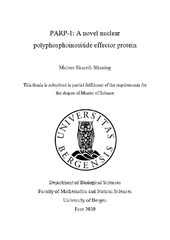| dc.description.abstract | Polyphosphoinositides (PPIns) are a family of seven signalling lipids that are important for many cellular processes. While their functional roles in the cytoplasm have been extensively studied, their roles in the nucleus are still poorly understood. To date, several members of the PI3K pathway have been identified within the nucleus, where they have shown to be involved in several nuclear functions such as DNA replication, DNA double strand break repair, and ribosome biogenesis. Previously, our group identified the class I PI3K p110b and its lipid product, PtdIns(3,4,5)P3 (PIP3) in the nucleoplasm and the nucleolus. To better understand the nuclear functions of PIP3, a nuclear PIP3 interactome was mapped using nuclear extracts from HeLa cells. Interestingly, many of the identified PIP3 binding proteins were annotated to the nucleolus, a subnuclear structure which is known as the site of ribosome biogenesis. Poly(ADP-ribose) polymerase-1 (PARP-1), an abundant nuclear protein involved in DNA repair and enriched in the nucleolus, was identified as a potential PIP3 binding protein. This was further confirmed by in vitro binding of PARP-1 to PPIns, including PIP3. Moreover, PARP-1 was shown to co-localize with PIP3 in the nucleolus in HeLa cells. In the present study, we aimed to determine the specific PIP3 interaction sites of PARP-1. We showed that PARP-1 binds to PPIns including PIP3 via two polybasic regions (PBRs) and through binding of one reverse K/R motif, as deletion of either of the PBRs or mutations in the K/R motif reduced or completely abolished all binding to PPIns. PARP-1 has been shown to be localized to the nucleolus, however no nucleolar localization signal has been determined so far. Using the nucleolar sequence detector (NoD) algorithm, we identified that one of the PPIn- binding sites could also act as a potential NoLS. Finally, we wanted to investigate whether PIP3 is important for the regulation of PARP-1 activity upon H2O2 induced DNA damage using MEF cells harbouring WT or kinase dead version of class I PI3K p110b. However, no differences were observed when comparing the PAR-intensities in the two cell lines. Taken together, these results further verify that PARP-1 is a novel PPIn effector protein, however, additional studies must be performed to map their functional role. | en_US |
